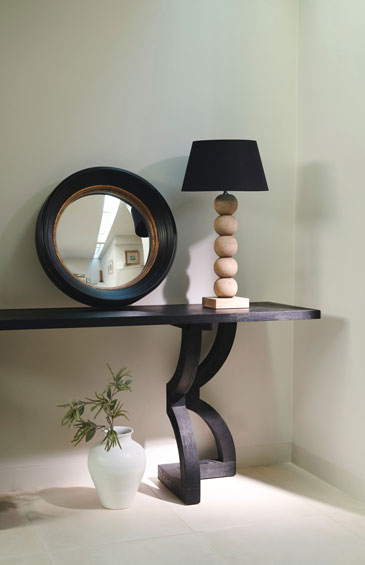Sam Wylie-Harris switches natural light for artificial, and reveals the best in statement lighting.
In the height of summer, lighting doesn’t have much opportunity to play a starring role. It’s more about window dressing to control the brightness.
But come early autumn, with dappled sunlight streaming through and a low sun casting shadows in our living space, a flick of a switch has the power to transform our interiors.
In many ways, luxe lighting offers the tools to illuminate, highlight and shine a spotlight on the things that make a difference in our lives, while setting the stage for a little bit of theatre.
Currently, sculptural forms and statement pieces are very on-trend, but neutrals and polished chrome are not forgotten. Here’s how to plug into the latest schemes…

1. Ribbon LED Ceiling Light by Heal’s, £479, other items from a selection, Heal’s
“Sculptural lighting can be a quick and easy way to create a focal point within a room, and is increasingly being used for decorative purposes,” says Claire Anstey, lighting buyer at Heal’s, “to the point where they can offer the same effect as a piece of art.”
As the evenings grow darker and we spend more time indoors, Anstey says lighting can be a great way to create drama in a space. Take their Ribbon pendant collection, “with its looping curves mimicking the movement of ribbons sweeping through the air.
“Suspended from a slim wire, the piece appears to be floating through the room and offers a touch of refined luxury – perfect for large living areas or poised above a dining table,” says Anstey.

2. Saber LED Multi Arm Chandelier, Gold, £399, Heal’s
In more contemporary schemes, linear designs work particularly well and can still offer the same level of impact with a crisp, clean glow. New for this season at Heal’s is the Saber multi-arm chandelier – a modern interpretation of the classic chandelier design. “Integrated LEDs offer an energy-saving alternative to traditional bulbs, and eight adjustable arms offer the flexibility to focus light within different areas of the room,” says Anstey.

3. Fin Pendant Grouping of 7, Natural White, £1,249, other items part of room set, Original BTC
Depending on the height of your ceilings, pendant lighting lends itself to spectacular dining settings, especially with the trend for tablescaping and entertaining at home.
As Peter Bowles, founder of Original BTC puts it: “When it comes to scale, dramatically proportioned lights are the most obvious way to create impact. A generously sized pendant will create a talking point, whether lit or not.”
While scale is one way to make a statement, it’s not always feasible to fit a grandly proportioned pendant in lower ceilinged rooms, so it’s worth exploring alternative approaches. “Often referred to as jewellery for the home, the right light fittings can complete or transform your interior scheme.” says Bowles. “Just like jewellery, a flash of brass, copper or gold can lift your room, bringing a touch of opulence.”

4. Cranton Hexagonal Pendant, Natural White, £2,969, Original BTC
Another scene stealer, if you’re looking for a central lighting source, this Instaworthy investment piece can be hung from a ceiling rose to contrast with traditional plasterwork.

5. Walter Pendant Size 2, Anthracite Glass & Brass, £459 each, Original BTC
When it comes to multiple light fittings, Bowles says three is the magic number. “Over a kitchen island or dining table, a row of three pendants will always create a strong visual impact and do all the hard work for you.”

6. Kartell Limited Edition Space Lamp, £183, Amara
Sam Hood, creative director and head of buying at Amara, says there’s a general move towards the use of lighting as a statement piece in a room – and we love this fabulously futuristic new arrival from Kartell. Depending on your budget, a pair would look stunning styled either side of a black leather sofa.

7. Humble One Table Light, White Marble, £129, Amara
Perhaps linked to increased environmental awareness, Hood says raw and natural looking colourways are also making an impact in decorative lighting. “Marble and wood patterns, seen in Humble’s new lighting range, add earthy accents to a room, particularly when placed next to indoor plants and other raw material features,” says Hood.

8. Brigantia Lighting Grey, £695 (£715 with bulb), other items from a selection, OKA
Elsewhere, basket style hanging lanterns have the power to please. “Lighting should be the star of the show in every space,” says Sue Jones, creative director for OKA. “If your ceiling height will allow it, dial up the drama with a hanging lamp that will act as a bold focal point. A style like the Brigantia is perfect to hang over a dining table as it will diffuse light and cast a soft glow.”

9. Perisphere Table Lamp – Natural, £175 (base only), Lamp & Black Drum Cotton Shade, £225, other items from a selection, OKA
Jones point out: “Remember lamps don’t have to be purely functional. A sculptural base like our new Perisphere table lamp will display just as much character when the lights are off, and can be paired with a patterned shade for an extra dash of colour.”

10. Grosvenor Floor Lamp, £115 (r), Grosvenor Table Lamp, £50 (m), Richmond Table Lamp, £90 (l), other items from a selection, Next
For a polished pool of light, this new Grosvenor collection from Next ticks all the right (light)boxes, with its chrome base complemented by a glamorous velvet shade with geometric design.

11. Jonathan Adler Constantine Table Lamp, £595, Jonathan Adler
This designer lamp is super stylish and chic. With its antiqued brass pyramid framework and lustrous piano black finish, it’s a fabulous edition to any side table.









